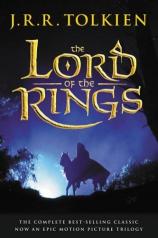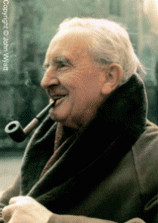The Lord of the Rings (Movie Art Cover)
Review
The Lord of the Rings (Movie Art Cover)
The old adage that "change is inevitable" is a message oft repeated, rephrased and expanded, from the ancient philosopher Heraclitus to the Terminator movies. But none has ever said it with quite the passion and resonance of J. R. R. Tolkien in his groundbreaking opus, THE LORD OF THE RINGS. This lengthy sequel to THE HOBBIT, mistakenly considered a trilogy due to its being published in three parts ("The Fellowship of the Ring," "The Two Towers," and "The Return of the King"), has maintained its reputation as the benchmark achievement of "sword-and-sorcery" literature for 47 years.
In the exquisitely detailed story of Middle-Earth's great war and the quest to destroy the One Ring, a token imbued with evil power, stands a fable for the ages echoing with the message that the future is ours to choose even in the face of inevitable change. This epic stands as such a singular achievement due in part to its broadly identifiable heroes, vivid realization of Middle-Earth and its history, and the epic scope of the story in which everyone is willing to risk themselves for the good of the world.
The story picks up some 60 years after THE HOBBIT, enjoying the same conspiratorial tone of narration as that of its predecessor. In the Shire, home of the diminutive, man-like race called Hobbits, we meet young Frodo, new owner of the Ring of Invisibility. The comforts of his rustic homeland become all the more dear to Frodo when he learns that his ring is the One Ring of Power, possessed of endless evil from its maker, the evil Sauron. Informed that Sauron is searching for the Ring --- the only thing standing between him and world domination --- and that the Ring will ultimately corrupt any one who owns it, Frodo undertakes a mission to travel across Middle-Earth to destroy the Ring in Sauron's own stronghold. Accompanied by three Hobbit friends --- Sam, Merry, and Pippin --- Gandalf the Wizard, and four others appointed as representatives of the free races of Middle-Earth, Frodo ventures beyond the world that he knows into the wild of the larger world and places fraught with peril. Each of the so-called "Nine Walkers" has a critical role to play in the course of events, both in the destruction of the Ring and in the coordination of the war against Sauron's forces.
Frodo himself is very much the Everyman with whom readers will identify so well. In his fear, indecision, and courage, the little hobbit represents anyone who reaches a point in life when they have to make irrevocable choices without certainty of the results. Faced with the choice to do nothing and risk harm to everyone he knows or to venture into the unknown alone, against his greatest fear, Frodo chooses --- time and again --- to do the right thing. "I feel that as long as the Shire lies behind, safe and comfortable, I shall find wandering more bearable…" Accompanying Frodo to the bitter end is his gardener, Sam Gamgee, a character possessed of an astounding level of loyalty to his employer. In Sam Gamgee, Tolkien crafted the true friend who stays with us through thick and thin and who would give us the shirt off his back without being asked. Sam remains overtly overprotective of Frodo from beginning to end, refusing to be left behind even for his own good and even forgoing food and water for Frodo's benefit. The choices that Sam is forced to make provide some of the book's most heartbreaking moments. The other hobbits, Merry and Pippin, display a range of irksome silliness and denial until pressed to hard choices, and both prove themselves worthy players on the stage of world affairs.
Through the character of Strider (Aragorn), a seasoned warrior wise beyond belief, Tolkien is able to interweave elements of mystery, bittersweet romance, unrequited love, predestination, and ultimate sacrifice. While every character is willing to expend themselves in the efforts to stop Sauron, Strider is the first after Gandalf to join the quest with a full understanding of the consequences of failure ("…if by life or death I can save you, I will"). The introduction of Strider also introduces us to the diversity of Middle-Earth through the many names by which the various races (Elves, Dwarves, nations of Men, Orcs) call him. Throughout most of the novel languages are interchanged, giving people, objects, and places a variety of names. In this way THE LORD OF THE RINGS realizes the gravity of the situation, that a vast group of divided nations are putting aside their differences to face a common enemy who threatens the entire world. This idea is also affirmed in the unconventional friendship that develops between Gimli the Dwarf and Legolas the Elf, whose races have a history of enmity dating back centuries.
Tolkien worked on this novel over the course of 13 years, a fact that becomes clear in the narrative tone that moves from conspiratorial to grimly melodramatic as the story moves towards its climax and the heroes' respective situations become dire ("So they were come to the bitter end"). The extent to which the author labored over this work is also apparent in the complete realizations he painted of each character and each race. The inherent qualities of the various species are thoroughly described in terms of the physical, spiritual, aesthetic, lingual, and intellectual. The speech and actions of each reinforces the images of "stupid Hobbits," "foul Orcs," "fair Elves," and "hardy Dwarves."
A lot of attention is also paid to the terrain of Middle-Earth as the travelers move from the lush, green comfort of the Shire to rough mountain passes and wastelands created by industrial processes. Whether the characters experience comfort or suffering in the wilderness, the reader feels the situation fully. The greatest evidence of Tolkien's extensive mythology-building is the 103 pages of appendices to which the text frequently refers. It is hard to say whether readers should refer to these whenever prompted or simply read the book straight through and then read the appendices. Either way, the appendices (which chronicle everything before and after this story, complete with maps, charts, and alphabets) is a stunning testament to the author's vision.
Reviewed by Sofrina Hinton on January 22, 2011










